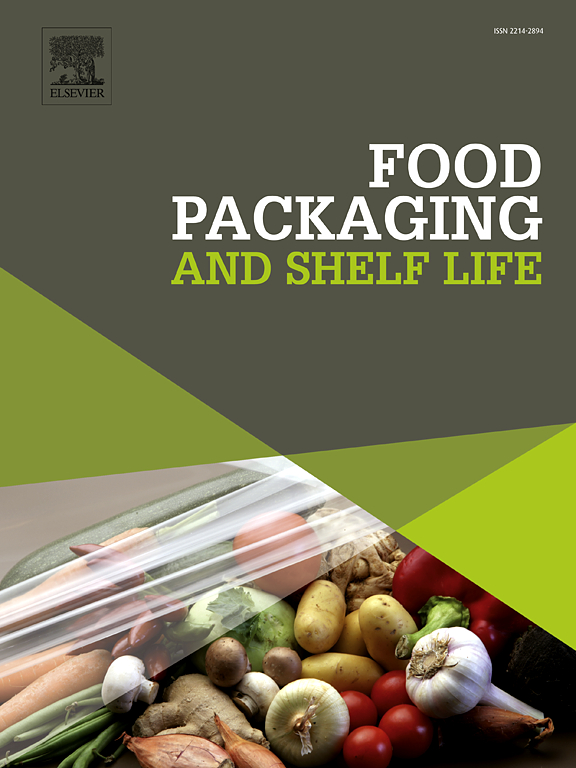新型ph敏感有机配体发光mof修饰CMC-Na/SA薄膜用于水果新鲜度实时监测
IF 8.5
1区 农林科学
Q1 FOOD SCIENCE & TECHNOLOGY
引用次数: 0
摘要
智能包装薄膜已被用于监测食品的新鲜度。然而,这种策略的局限性包括包装材料综合性能的限制和视觉反应精度的降低,这进一步限制了它的广泛应用。本文通过溶剂热法合成了纳米金属有机框架(mof),并对其结构和形态属性进行了检测,同时对其光学性质进行了研究。选择铕(Eu)基mof作为荧光背景信号,而氨基和羟基功能化的Eu- mof作为ph响应信号。随后,将mof纳米材料嵌入到羧甲基纤维素钠(CMC-Na)和海藻酸钠(SA)底物的混合基质中,制备co2响应包装薄膜。将发光mof集成到薄膜衬底中产生了许多有利的特性,例如优异的疏水性和耐水性,增强的机械性能和增强的热稳定性。特别是,基于MOF的复合膜具有较好的UV-vis阻隔能力,优异的MOF指标的耐迁移性,以及显著的时间-温度稳定性。最后,利用智能手机应用程序验证了mofs薄膜的srgb值与鲜切芒果在4℃下的理化特性(硬度和总可溶性固形物)之间的关系,建立了显著的线性相关(R2 = 0.9829和0.9865)。因此,基于智能手机的数字传感平台开创了鲜切水果新鲜度现场快速定量评估的新方法,对于提高智能包装领域的准确性和便利性具有重要意义。本文章由计算机程序翻译,如有差异,请以英文原文为准。
Novel pH-sensitive organic ligand-based luminescent MOFs modified CMC-Na/SA films for real-time monitoring of fruit freshness
Intelligent packaging films have been employed for the monitoring of food freshness. However, the limitations of this strategy encompass the restricted comprehensive performance of the packaging materials and the diminished visual response accuracy, which further curtail its broader application. Herein, the synthesis of nano-metal organic frameworks (MOFs) via the solvothermal method was accompanied by the examination of their structural and morphological attributes, alongside an investigation into their optical properties. The europium (Eu)-based MOFs were selected to serve as the fluorescence background signal, while the amino- and hydroxyl- functionalized Eu-MOFs were utilized as pH-responsive signals. Subsequently, the MOFs nanomaterials were embedded into a blended matrix of sodium carboxymethyl cellulose (CMC-Na) and sodium alginate (SA) substrate to fabricate a CO2-responsive packaging film. The integration of luminescent MOFs into the film substrate resulted in a multitude of advantageous characteristics, such as excellent hydrophobicity and water resistance, enhanced mechanical properties, and augmented thermal stability. Especially, the MOFs-based composite film demonstrated improved UV–vis barrier capability, superior migration resistance of the MOF indicators, and remarkable time-temperature stability. Lastly, a significant linear correlation (R2 = 0.9829 and 0.9865) was established using a smartphone application to demonstrate the relationship between the SRGB-values of MOFs-based films and physicochemical characteristics (hardness and total soluble solids (TSS)) of fresh-cut Narcissus mangoes at 4 ℃, respectively. Therefore, the smartphone-based digital sensing platform pioneers a novel approach for the on-site rapid quantitative assessment of fresh-cut fruit freshness, which holds considerable significance for improving accuracy and convenience in the field of intelligent packaging.
求助全文
通过发布文献求助,成功后即可免费获取论文全文。
去求助
来源期刊

Food Packaging and Shelf Life
Agricultural and Biological Sciences-Food Science
CiteScore
14.00
自引率
8.80%
发文量
214
审稿时长
70 days
期刊介绍:
Food packaging is crucial for preserving food integrity throughout the distribution chain. It safeguards against contamination by physical, chemical, and biological agents, ensuring the safety and quality of processed foods. The evolution of novel food packaging, including modified atmosphere and active packaging, has extended shelf life, enhancing convenience for consumers. Shelf life, the duration a perishable item remains suitable for sale, use, or consumption, is intricately linked with food packaging, emphasizing its role in maintaining product quality and safety.
 求助内容:
求助内容: 应助结果提醒方式:
应助结果提醒方式:


